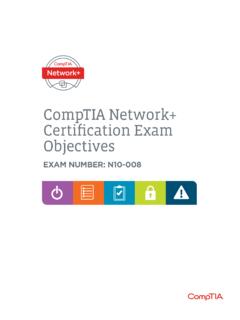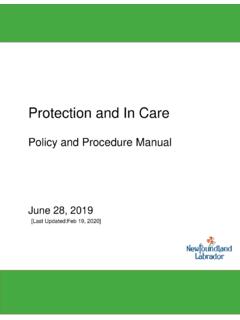Transcription of CompTIA Cybersecurity Analyst (CySA+) Certification Exam ...
1 CompTIA Cybersecurity Analyst (CySA+) Certification Exam ObjectivesEXAM NUMBER: CS0-002 About the ExamCompTIA Cybersecurity Analyst (CySA+) Certification Exam Objectives (Exam Number: CS0-002)Candidates are encouraged to use this document to help prepare for the CompTIA Cybersecurity Analyst (CySA+) CS0-002 Certification exam. With the end goal of proactively defending and continuously improving the security of an organization, CySA+ will verify the successful candidate has the knowledge and skills required to: Leverage intelligence and threat detection techniques Analyze and interpret data Identify and address vulnerabilities Suggest preventative measures Effectively respond to and recover from incidentsThis is equivalent to 4 years of hands-on experience in a technical Cybersecurity job content examples are meant to clarify the test objectives and should not be construed as a comprehensive listing of all the content of this DEVELOPMENTCompTIA exams result from subject matter expert workshops and industry-wide survey results regarding the skills and knowledge required of an IT AUTHORIZED MATERIALS USE POLICY CompTIA Certifications, LLC is not affiliated with and does not authorize, endorse or condone utilizing any content provided by unauthorized third-party training sites (aka brain dumps ).
2 Individuals who utilize such materials in preparation for any CompTIA examination will have their certifications revoked and be suspended from future testing in accordance with the CompTIA Candidate Agreement. In an effort to more clearly communicate CompTIA s exam policies on use of unauthorized study materials, CompTIA directs all Certification candidates to the CompTIA Certification Exam Policies. Please review all CompTIA policies before beginning the study process for any CompTIA exam. Candidates will be required to abide by the CompTIA Candidate Agreement. If a candidate has a question as to whether study materials are considered unauthorized (aka brain dumps ), he/she should contact CompTIA at to NOTEThe lists of examples provided in bulleted format are not exhaustive lists. Other examples of technologies, processes, or tasks pertaining to each objective may also be included on the exam although not listed or covered in this objectives document.
3 CompTIA is constantly reviewing the content of our exams and updating test questions to be sure our exams are current and the security of the questions is protected. When necessary, we will publish updated exams based on testing exam objectives. Please know that all related exam preparation materials will still be DETAILSR equired exam CS0-002 Number of questions Minimum of 85 Type of questions Multiple choice and performance-based Length of test 165 minutesRecommended experience 4 years of hands-on experience in a technical Cybersecurity job role Security+ and Network+, or equivalent knowledge and experiencePassing score 750 EXAM OBJECTIVES (DOMAINS)The table below lists the domains measured by this examination and the extent to which they are represented. CompTIA Cybersecurity Analyst (CySA+) Certification Exam Objectives (Exam Number.)
4 CS0-002)DOMAIN PERCENTAGE OF Threat and Vulnerability Management 22% Software and Systems Security 18% Security Operations and Monitoring 25% Incident Response 22% Compliance and Assessment 13% Total 100% Intelligence sources - Open-source intelligence - Proprietary/closed-source intelligence - Timeliness - Relevancy - Accuracy Confidence levels Indicator management - Structured Threat Information eXpression (STIX) - Trusted Automated eXchange of Indicator Information (TAXII) - OpenIoC Threat classification - Known threat vs. unknown threat - Zero-day - Advanced persistent threat Threat actors - Nation-state - Hacktivist - Organized crime - Insider threat - Intentional - Unintentional Intelligence cycle - Requirements - Collection - Analysis - Dissemination - Feedback Commodity malware Information sharing and analysis communities - Healthcare - Financial - Aviation - Government - Critical infrastructure Attack frameworks - MITRE ATT&CK - The Diamond Model of Intrusion Analysis - Kill chain Threat research - Reputational - Behavioral - Indicator of compromise (IoC) - Common vulnerability scoring system (CVSS)
5 Threat modeling methodologies - Adversary capability - Total attack surface - Attack vector - Impact - Likelihood Threat intelligence sharing with supported functions - Incident response - Vulnerability management - Risk management - Security engineering - Detection and Threat and Vulnerability ManagementExplain the importance of threat data and a scenario, utilize threat intelligence to support organizational Cybersecurity Analyst (CySA+) Certification Exam Objectives (Exam Number: CS0-002) Threat and Vulnerability ManagementGiven a scenario, perform vulnerability management Vulnerability identification - Asset criticality - Active vs. passive scanning - Mapping/enumeration Validation - True positive - False positive - True negative - False negative Remediation/mitigation - Configuration baseline - Patching - Hardening - Compensating controls - Risk acceptance - Verification of mitigation Scanning parameters and criteria - Risks associated with scanning activities - Vulnerability feed - Scope - Credentialed vs.
6 Non-credentialed - Server-based vs. agent-based - Internal vs. external - Special considerations - Types of data - Technical constraints - Workflow - Sensitivity levels - Regulatory requirements - Segmentation - Intrusion prevention system (IPS), intrusion detection system (IDS), and firewall settings Inhibitors to remediation - memorandum of understanding (MOU) - Service-level agreement (SLA) - Organizational governance - Business process interruption - Degrading functionality - Legacy systems - Proprietary systems Web application scanner - OWASP Zed Attack Proxy (ZAP) - Burp suite - Nikto - Arachni Infrastructure vulnerability scanner - Nessus - OpenVAS - Qualys Software assessment tools and techniques - Static analysis - Dynamic analysis - Reverse engineering - Fuzzing Enumeration - Nmap - hping - Active vs. passive - Responder Wireless assessment tools - Aircrack-ng - Reaver - oclHashcat Cloud infrastructure assessment tools - ScoutSuite - Prowler - Pacu Mobile Internet of Things (IoT) Embedded Real-time operating system (RTOS) System-on-Chip (SoC) Field programmable gate array (FPGA) Physical access control Building automation systems Vehicles and drones - CAN bus Workflow and process automation systems Industrial control system Supervisory control and data acquisition (SCADA) - ModbusGiven a scenario, analyze the output from common vulnerability assessment the threats and vulnerabilities associated with specialized Cybersecurity Analyst (CySA+) Certification Exam Objectives (Exam Number.)
7 CS0-002)Explain the threats and vulnerabilities associated with operating in the Cloud service models - Software as a Service (SaaS) - Platform as a Service (PaaS) - Infrastructure as a Service (IaaS) Cloud deployment models - Public - Private - Community - Hybrid Function as a Service (FaaS)/ serverless architecture Infrastructure as code (IaC) Insecure application programming interface (API) Improper key management Unprotected storage Logging and monitoring - Insufficient logging and monitoring - Inability to accessGiven a scenario, implement controls to mitigate attacks and software vulnerabilities. Attack types - Extensible markup language (XML) attack - Structured query language (SQL) injection - Overflow attack - Buffer - Integer - Heap - Remote code execution - Directory traversal - Privilege escalation - Password spraying - Credential stuffing - Impersonation - On-path attack (previously known as man-in-the-middle attack) - Session hijacking - Rootkit - Cross-site scripting - Reflected - Persistent - Document object model (DOM) Vulnerabilities - Improper error handling - Dereferencing - Insecure object reference - Race condition - Broken authentication - Sensitive data exposure - Insecure components - Insufficient logging and monitoring - Weak or default configurations - Use of insecure functions - Cybersecurity Analyst (CySA+)
8 Certification Exam Objectives (Exam Number: CS0-002) Threat and Vulnerability Software and Systems Security Cloud vs. on-premises Asset management - Asset tagging Segmentation - Physical - Virtual - Jumpbox - System isolation - Air gap Network architecture - Physical - Software-defined - Virtual private cloud (VPC) - Virtual private network (VPN) - Serverless Change management Virtualization - Virtual desktop infrastructure (VDI) Containerization Identity and access management - Privilege management - Multifactor authentication (MFA) - Single sign-on (SSO) - Federation - Role-based - Attribute-based - Mandatory - Manual review Cloud access security broker (CASB) Honeypot Monitoring and logging Encryption Certificate management Active defense Platforms - Mobile - Web application - Client/server - Embedded - System-on-chip (SoC) - Firmware Software development life cycle (SDLC) integration DevSecOps Software assessment methods - User acceptance testing - Stress test application - Security regression testing - Code review Secure coding best practices - Input validation - Output encoding - Session management - Authentication - Data protection - Parameterized queries Static analysis tools Dynamic analysis tools Formal methods for verification of critical software Service-oriented architecture - Security Assertions Markup Language (SAML) - Simple Object Access Protocol (SOAP) - Representational State Transfer (REST) - Microservices Hardware root of trust - Trusted platform module (TPM) - Hardware security module (HSM) eFuse Unified Extensible Firmware Interface (UEFI)
9 Trusted foundry Secure processing - Trusted execution - Secure enclave - Processor security extensions - Atomic execution Anti-tamper Self-encrypting drive Trusted firmware updates Measured boot and attestation Bus encryptionGiven a scenario, apply security solutions for infrastructure software assurance best hardware assurance best Cybersecurity Analyst (CySA+) Certification Exam Objectives (Exam Number: CS0-002) Security Operations and Monitoring Heuristics Trend analysis Endpoint - Malware - Reverse engineering - Memory - System and application behavior - Known-good behavior - Anomalous behavior - Exploit techniques - File system - User and entity behavior analytics (UEBA) Network - Uniform Resource Locator (URL) and domain name system (DNS) analysis - Domain generation algorithm - Flow analysis - Packet and protocol analysis - Malware Log review - Event logs - Syslog - Firewall logs - Web application firewall (WAF) - Proxy - Intrusion detection system (IDS)/ Intrusion prevention system (IPS) Impact analysis - Organization impact vs.
10 Localized impact - Immediate vs. total Security information and event management (SIEM) review - Rule writing - Known-bad Internet protocol (IP) - Dashboard Query writing - String search - Script - Piping E-mail analysis - Malicious payload - Domain Keys Identified Mail (DKIM) - Domain-based Message Authentication, Reporting, and Conformance (DMARC) - Sender Policy Framework (SPF) - Phishing - Forwarding - Digital signature - E-mail signature block - Embedded links - Impersonation - Header Permissions Allow list (previously known as whitelisting) Blocklist (previously known as blacklisting) Firewall Intrusion prevention system (IPS) rules Data loss prevention (DLP) Endpoint detection and response (EDR) Network access control (NAC) Sinkholing Malware signatures - Development/rule writing Sandboxing Port securityGiven a scenario, analyze data as part of security monitoring a scenario, implement configuration changes to existing controls to improve Cybersecurity Analyst (CySA+) Certification Exam Objectives (Exam Number.)









